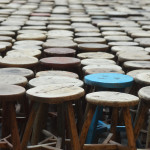
My first encounter with a botánica coincided with the first time I set foot in Los Angeles. A freshman in college, my introductory sociology class had Metrolinked in from the Inland Empire for a walking tour of downtown. Set free in Grand Central Market to find something to eat, I wolfed a burrito and took a self-guided tour around the block, stumbling upon what looked to be a treasure-shop. It was a botánica, and it was more interesting than food.
An ubiquitous sight in many of Los Angeles’s neighborhoods, it is hard to categorize the nature of a botánica’s business at first glance—they tend to be small and nestled between restaurants, massage parlors, and discount stores, blending in with both boulevard and strip mall landscapes. And upon closer investigation, situational or academic, it is still hard to categorize the nature of their business. Dealing in candles, incense, laminated prayer cards, oils, powders, herbs, and effigies, the botánica operates precisely within that blurred region where rigid definitions of religion and culture no longer reign—like Los Angeles itself.

Four years after my first encounter, I live in East Hollywood and there are four or five botánicas within walking distance of my apartment. Generally considered an organic import from LA’s Latino population, the number of botánicas in the city has exploded since the early 1990s. While the LA botánica might be brought from Mexico and Central and South America, the range of merchandise attests to complex syncretism that has been centuries in the making.
Side by side on the shelves are effigies of saints descending from the African Yoruba traditions, brought to the western hemisphere by slaves, Roman Catholic stand-bys such St. Christopher and St. Jude, and saints decidedly not recognized by the Vatican, such as la Santa Muerte.


I frequent El Negro José and bombard Vitilino, the Guatemalan owner, with questions. His shop is just off a busy corner in East Hollywood. He lets me sit and browse through a book on Guatemala’s favored San Simón on a worn black couch. The shop is filled with unopened cardboard boxes from Indio LLC., the primary supplier of botánica merchandise in the US—a company that manufactures their products in a border maquiladora. Next to and on top of the boxes, an army of the warrior orisha Ogún pounds—Ogún is the patron of iron, chains, keys, and jails.
Vitilino is patient with me as I learn to recognize each figure, pointing and asking questions. Elegua sits at the door—”Elegua opens and closes doors?” I ask. “Yes, like St. Peter,” answers Vitilino. “St. Peter up there,” he says pointing to the sky, “and Elegua down here.” He laughs. Nickels are meticulously stacked at the feet of a three-foot tall St. Lazarus, and folded dollars are tied around his arms and walking stick. A large Santísima Muerte, related to the pre-Colombian goddess Mictecacihuatl, seems to preside over the shop on a high shelf, scythe in hand.

Figures like la Santa Muerte are sometimes called “folk saints,” which are used popularly but have never been formally acknowledged by the Catholic Church. To the botánica, this type of formality is irrelevant. They operate according to how their customers choose to worship and there are many interpretations and uses of the same object. Personal improvisation can even be encouraged—Vitilino refuses to make charms or altars for customers, explaining that the spiritual work is much better if the person makes it on their own, “putting themselves into it.”
Another renegade saint is Jesús Malverde—a Robin Hood figure thought to give protection from the law, he is also the patron of US-Mexico drug traffickers. Testifying to the cultural force of folk saints, in 2009, Mexican authorities destroyed over 30 public altars to la Santa Muerte and Jesús Malverde, a new tactic in the country’s war against its violent drug economy.
Vitilino tells me that “everyone” comes into his shop. He lists off terms that I pause to ask him to clarify—las islas (from the Caribbean islands), los Mexicanos, los morenos (literally “the browns,” from Central and South America), los Armenios (Armenians), los Italianos, and then he points to me—”American,” I say. He reminds me of what should’ve stuck from a fancy liberal arts education—that “American” applies to anyone from Canada, the U.S., Mexico, Central and South America. “Estadounidense,” I clarify.

Public interest in the botánica takes form in the occasional LA Times article, and seems to be growing. In 2004, the UCLA Fowler Museum hosted the exhibition Botánica LA: Latino Popular Religious Art in the City of Angels, bringing to light the fluidity of art, religion, medicine, and culture thriving in LA.
In one nearby botánica, I meet a jewelry-adorned curandero (shamanic healer) his fingernails painted black. He turns out to be Charles Guelperín, a type of celebrity in the botánica world. A Santería priest and former nightclub owner, Guelperín teaches at UCLA and is often quoted in the LA Times and featured on NPR.
His shop sits literally in the shadow of Harvey Apartments, where a suspect in the high-profile Ronni Chasen murder shot himself. The building’s massive mural of Marilyn Monroe, James Dean, Arnold Schwarzenegger, and the Beatles looms to the left as I examine the window display.
It is a city of angels, to be sure.









Fascinating socio-folk-local-global synthesis
Your mom was telling us about this fantastic piece last night and sent the link today. I really enjoyed reading this–and what great pics!
Hope to see you when you’re home over the holidays.
love, Susan